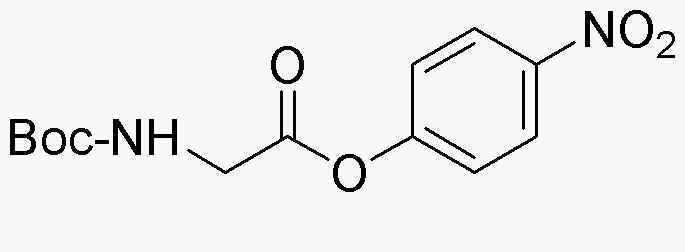Boc-glycine 4-nitrophenyl ester is widely utilized in research focused on:
- Peptide Synthesis: This compound serves as a protective group in the synthesis of peptides, allowing for selective reactions without affecting other functional groups. Its use simplifies the process of building complex peptide chains.
- Drug Development: In medicinal chemistry, it acts as an intermediate in the development of pharmaceutical compounds, particularly those targeting specific biological pathways. This can lead to more effective drugs with fewer side effects.
- Bioconjugation: The compound is valuable in bioconjugation techniques, where it helps attach biomolecules to surfaces or other molecules, enhancing the functionality of diagnostic tools and therapeutic agents.
- Research in Enzyme Inhibition: It is utilized in studies aimed at understanding enzyme mechanisms, particularly in the design of enzyme inhibitors that can lead to new treatments for diseases.
- Analytical Chemistry: Boc-glycine 4-nitrophenyl ester is used as a reagent in various analytical methods, aiding in the detection and quantification of amino acids and peptides in complex mixtures.
General Information
Properties
Safety and Regulations
Applications
Boc-glycine 4-nitrophenyl ester is widely utilized in research focused on:
- Peptide Synthesis: This compound serves as a protective group in the synthesis of peptides, allowing for selective reactions without affecting other functional groups. Its use simplifies the process of building complex peptide chains.
- Drug Development: In medicinal chemistry, it acts as an intermediate in the development of pharmaceutical compounds, particularly those targeting specific biological pathways. This can lead to more effective drugs with fewer side effects.
- Bioconjugation: The compound is valuable in bioconjugation techniques, where it helps attach biomolecules to surfaces or other molecules, enhancing the functionality of diagnostic tools and therapeutic agents.
- Research in Enzyme Inhibition: It is utilized in studies aimed at understanding enzyme mechanisms, particularly in the design of enzyme inhibitors that can lead to new treatments for diseases.
- Analytical Chemistry: Boc-glycine 4-nitrophenyl ester is used as a reagent in various analytical methods, aiding in the detection and quantification of amino acids and peptides in complex mixtures.
Documents
Safety Data Sheets (SDS)
The SDS provides comprehensive safety information on handling, storage, and disposal of the product.
Product Specification (PS)
The PS provides a comprehensive breakdown of the product’s properties, including chemical composition, physical state, purity, and storage requirements. It also details acceptable quality ranges and the product's intended applications.
Certificates of Analysis (COA)
Search for Certificates of Analysis (COA) by entering the products Lot Number. Lot and Batch Numbers can be found on a product’s label following the words ‘Lot’ or ‘Batch’.
*Catalog Number
*Lot Number
Certificates Of Origin (COO)
This COO confirms the country where the product was manufactured, and also details the materials and components used in it and whether it is derived from natural, synthetic, or other specific sources. This certificate may be required for customs, trade, and regulatory compliance.
*Catalog Number
*Lot Number
Safety Data Sheets (SDS)
The SDS provides comprehensive safety information on handling, storage, and disposal of the product.
DownloadProduct Specification (PS)
The PS provides a comprehensive breakdown of the product’s properties, including chemical composition, physical state, purity, and storage requirements. It also details acceptable quality ranges and the product's intended applications.
DownloadCertificates of Analysis (COA)
Search for Certificates of Analysis (COA) by entering the products Lot Number. Lot and Batch Numbers can be found on a product’s label following the words ‘Lot’ or ‘Batch’.
*Catalog Number
*Lot Number
Certificates Of Origin (COO)
This COO confirms the country where the product was manufactured, and also details the materials and components used in it and whether it is derived from natural, synthetic, or other specific sources. This certificate may be required for customs, trade, and regulatory compliance.

